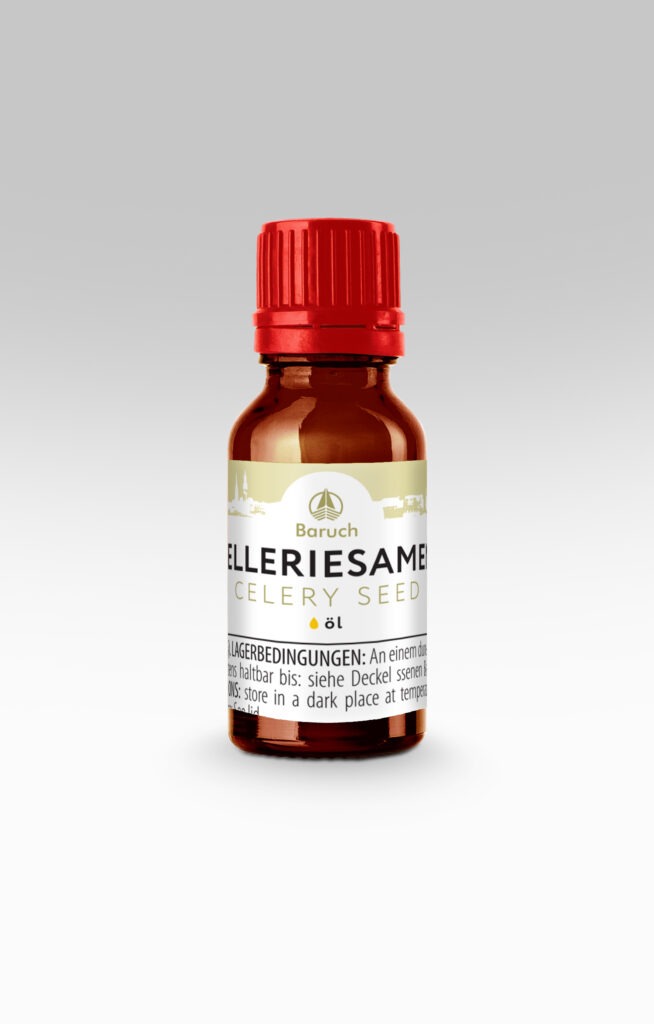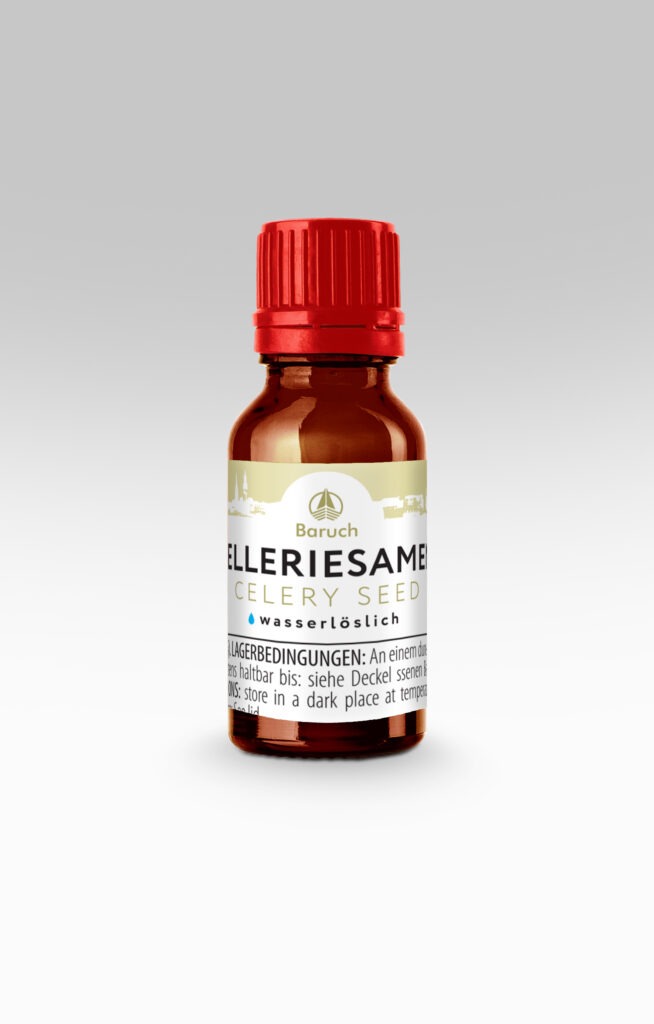In practice, what is usually simply called celery is a plant called real celery, celery, or celera. Celery is widely grown as a vegetable.
All parts of the plant are used as a seasoning and flavoring spice for food. At the same time, celery was almost always considered a medicinal plant. In folk medicine, it has been used to treat malaria, urticaria, liver diseases, and neuroses. The effectiveness of aromatic essential celery oil in the fight against inflammatory processes and for relieving pain in the gastrointestinal tract has recently been proven in special studies. Taking preparations containing lipophilic celery compounds reduces the permeability of the vessel walls, for example in the case of hemorrhagic vesiculitis. The beneficial effect of celery in diabetes mellitus, allergic urticaria, edema and rheumatism has been proven. Since CO2 extracts are practically the counterpart to the corresponding essential oils, it is possible to extend the proven healing properties of celery essential oil to a similar extract.
Celery leaves, stems and rhizomes have a pleasantly spicy, slightly bitter taste and a strong characteristic aroma with notes of citrus or lemon. In the case of celery seeds, these organoleptic properties are even more pronounced. Oil solutions of the CO2 extract from celery seeds are ideal for adding to salads or steamed vegetables. They add extra flavor and aroma to broths or fried chicken, turkey, and pork ribs. Such a solution of the CO2 extract can be used to make savory sauces and, in the form of a microemulsion, to make cocktails with gin and tequila.
Celery CO2 extract is a clear, oily liquid of yellow-orange color with a strong, characteristic, spicy aroma.


Chart 1. The main components of the CO2 extract of celery
| NAME | CONTENT IN% OF THE AMOUNT OF VOLATILE COMPONENTS | EFFECT |
|---|---|---|
| Limonene | 60 | Antibacterial, antidepressant and immune stimulating. Shows anti-inflammatory and antioxidant properties. |
| Apiol | 5 | Diuretic, lowering fever. Strongly antispasmodic. |
| Beta-Celinen | 13 | Expectorant. |
| Santalol | 3 | Anthelmintic, antihypertensive, bactericidal, stimulates the nervous system. |
| Sedanolide | 2,1 | Anti-inflammatory, antispasmodic, diuretic, choleretic, digestive, sweaty and calming. |
| Carvone | 1,7 | Nervous system stimulant, anthelmintic. |
| Alpha-linolenic acid | 1,4 | Unsaturated. an essential fatty acid from the class of omega-3 fatty acids. It has a membrane protecting, angioprotective effect. Immunomodulatory, improves metabolism in the brain. |
| Linoleic acid | 2,3 | An essential unsaturated fatty acid of the omega-6 class. It has anti-inflammatory, vasoconstrictor, and aggregating effects. If there is no balance between omega-3 and omega-6 fatty acids, competitive processes can arise that influence the metabolism. |
| 3-butylphthalide | 1,3 | Helps lower triglyceride levels, reduces the amount of low-density lipoproteins (cholesterol). |
Substances based on the CO2 extract from celery seeds are well suited for use in cosmetic formulations:
- preparations for combating age spots, inflammation, pigment spots and scars;
- in preparations for moisturizing, cleaning the skin and removing edema, including under the eyes;
- in cosmetic creams for oily and problematic skin that have a regenerating and nourishing effect;
- in hair care products to normalize the sebum glands and to strengthen the hair
Real celery is well known and grown everywhere. The city of Portage in the United States is considered the capital of celery, and the tradition of stirring the Bloody Mary cocktail with celery stalks originated in Chicago. In addition to carrots and onions, French culinary experts also consider celery to be part of the “Holy Trinity”. According to ancient Greek myths, the cave of the nymph Calypso, in which Odysseus hid for seven years, was surrounded by celery thickets. In ancient Greece, celery was considered a sacred medicinal plant and its use as a food was only allowed under special circumstances.
Chart 2. Application rates, recommendations for the use and storage of CO2 extract from celery
| Food usage rates | Item А100: 0.001-0.005% (10-50g per ton) Water-soluble microemulsions EMA1: 0.1-0.5% (1-5l per 1000l or 1-5ml per liter) Water-soluble microemulsions EMA5: 0.02-0.1% (0.2-1l per 1000l or 0.2-1ml per liter) |
| Application rates in cosmetics | Item А10: 1-3% Item А100: 0.1-0.3% Item EMA1: 10-30% Item EMA5: 2-6% |
| Recommendations for use | It is recommended to add CO2 extracts in the final stages of preparation, in the cooling phase of the end product. |
| Storage advice | It is recommended to store CO2 extracts in a closed container in a cool room and avoid direct sunlight. |
| Use in dietary supplements | Application in cooking | Application in cosmetics |
| It is recommended for the treatment of malaria, urticaria, liver diseases and neuroses. Recently, specific studies have shown the effectiveness of celery lipophilic compounds in fighting inflammatory processes and relieving pain in the gastrointestinal tract. Taking preparations containing lipophilic compounds of celery reduces the permeability of the walls of blood vessels, for example, with hemorrhagic vesiculitis. The beneficial effect of celery in diabetes mellitus, allergic urticaria, edema diseases and rheumatism has been proven. | The CO2 in celery seed extract is great for adding to salads or vegetable stews. It adds extra flavor and aroma to broths or roasted chicken, turkey, pork ribs. This CO2 extract can be used to make savory sauces and, in the form of a microemulsion, to make cocktails with gin and tequila. | Celery seed CO2 extract is well suited for incorporation into cosmetic formulations to combat age spots, inflammation, even out skin color and remove scars, in preparations for moisturizing, cleansing the skin and removing puffiness, including under the eyes, in cosmetics From creams for oily and problematic skin with regenerating, anti-aging and nourishing effects to hair care products intended to normalize the function of the sebaceous glands and strengthen the hair. |
